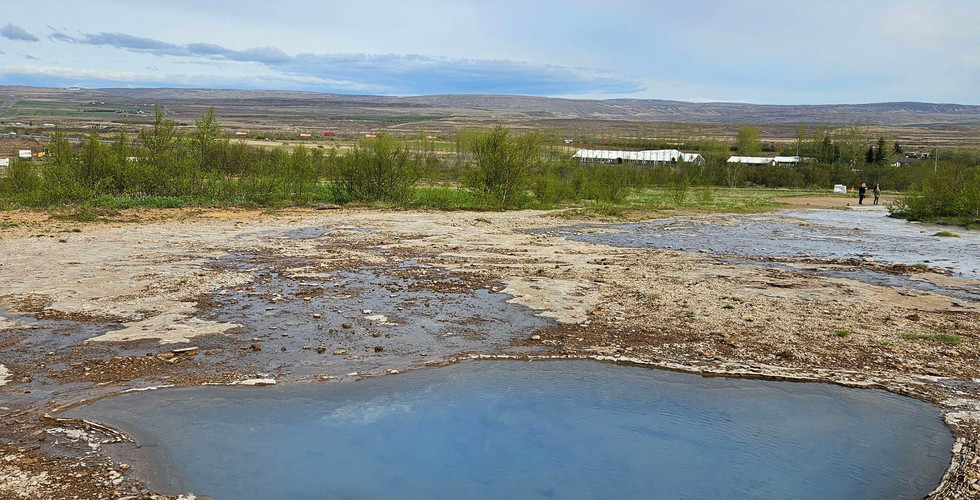When you think of a cold place like Iceland, you might not envision boiling water jets steaming and shooting out of the ground. However, Iceland is a land of contrasts, with its glaciers, fjords, and snow juxtaposed against volcanoes, hot springs, and geysers. Let me take you on a journey to explore Iceland's natural beauty, from visiting hot springs and learning how geysers work to watching the Strokkur Geyser erupt. I'll also share some tips if you plan to visit Iceland yourself!

We made several stops as we drove around the Golden Circle, including at the geysers between Þingvellir National Park and Gullfoss Waterfalls. Upon arriving at the Geysers Visitor Center in Haukadalur Valley, we parked the car and headed straight for the geothermal wonders. I walked past various geysers, each differing in size and activity. We followed a trail marked with "Caution: Hot Water" signs. After passing a few smaller geysers and bubbling hot springs, we reached the impressive Strokkur Geyser. Every few minutes, Strokkur erupted, shooting boiling water up to 30 feet into the air! The eruption sent steaming water everywhere and emitted a strong, unpleasant smell of sulfuric acid and hydrogen sulfide, reminiscent of rotten eggs. After escaping the pungent scent, we explored other geysers. While most of them didn't erupt, they were still mesmerizing with their beautiful blue hues, thanks to the sulfur in the water.
Even in boiling water, some microorganisms, like algae and bacteria, can thrive inside these geysers, which is incredible. Sometimes, these tiny organisms produce pigments that color the geyser pools. The water in these geysers is rich in minerals, including sulfur and various metal ions. These minerals can create vibrant colors in the water, making it appear blue, yellow, or green!
Although the Strokkur Geyser may appear to be a small blue-green pool on the surface, the geothermal activity beneath the Earth's surface causes much more to happen, including the presence of microorganisms (blue-green), silica (white), and sulfur (yellow). The pool is only 4 feet deep, but a conduit or channel below goes down 75 feet, leading to a chamber sitting atop molten hot magma. When the water reaches boiling point, and the pressure builds up, it pushes the water through the conduit into the sky, reaching heights of 49 to 66 feet. Did you know that water beneath the surface can reach temperatures higher than 250 degrees Fahrenheit and shoot up at speeds of 37 miles per hour? After an eruption, there is a resting period of 5-10 minutes, during which the chamber is empty. This period can last from minutes to days or even longer in some geysers! After an eruption, there is a resting period of 5-10 minutes, during which the chamber is empty. This period can last from minutes to days or even longer in some geysers! The cycle begins again as groundwater seeps into the channel and replenishes itself.
If you plan on visiting Strokkur or any geyser, keep a few things in mind:
First, don’t push through the crowd to get to the pool. This is a really bad idea! When the geyser erupts, it will spray boiling water everywhere, potentially causing third-degree burns. Also, please do not go into restricted areas; they are closed for a reason. The water there can be over 250°F (120°C) and is extremely dangerous.
Second, be prepared for the smell. After each eruption, you’ll likely notice a strong odor similar to rotten eggs. This is due to the excess hydrogen sulfide gas in the air.
Third, souvenirs at the geyser sites can be very expensive. A snow globe costs $30, so buy your geyser merchandise elsewhere.
Also, don’t expect all the geysers to be active; usually, one or two will be fully active while the others are not.
Finally, remember to watch the geysers with your eyes, not just through your phone. Many people miss the experience by only viewing it through their screens.
I hope you enjoyed learning about the beautiful Strokkur Geyser, and maybe one day you visit yourself!
Until next time- See you, blog world!
Works Cited
“Geysir | Geothermal, Strokkur, Hot Springs.” Britannica, https://www.britannica.com/place/Geysir. Accessed 14 July 2024.
“Iceland's Mesmerizing Strokkur Geyser | HX Hurtigruten Expeditions US.” Hurtigruten Expeditions, https://www.travelhx.com/en-us/stories/strokkur-geyser/. Accessed 14 July 2024.
“The Mighty Geyser.” Guide to Iceland, https://guidetoiceland.is/travel-iceland/drive/strokkur. Accessed 14 July 2024.



































